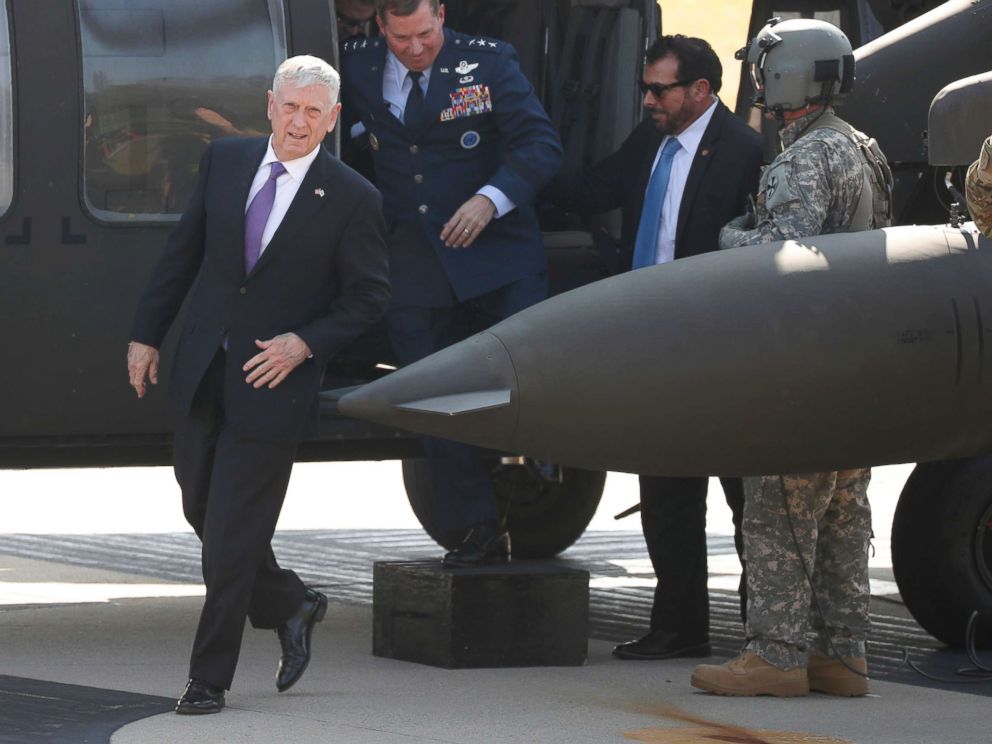|
U.S. Defense Secretary James Mattis visited Friday morning the heavily fortified border between North Korea and South Korea known as the Demilitarized Zone amid heightened tensions over the North's nuclear program and the war of words between President Trump and Kim Jong Un.
At the DMZ, Mattis was briefed at Observation Point Oullette by South Korean Defense Minister Song Young-moo. Joint Security Area Commander Lt. Col. Matthew S. Farmer was also there, as was his South Korean counterpart, Army Battalion Commander Lt. Col. Kwon, Yong-hwan.
With the aid of poster boards, Song gave Mattis a brief history of battles fought at the DMZ. Mattis also received an overview of the surrounding area from a U.S. commander, who pointed out "Propaganda Village," situated in the North's half of the DMZ.
Mattis accused North Korea of building a nuclear arsenal to "threaten others with catastrophe" and said the Trump administration remains committed to forcing the North to accept nuclear disarmament.
"We stand should to shoulder with you and the Korean people in confronting the threats posed by the Kim Jong Un regime," Mattis said as looked on. He returned to Seoul following his visit to the DMZ.
Mattis called the North "an oppressive regime that shackles its people, denying their freedom, their welfare and their human dignity in pursuit of nuclear weapons and their means of delivery in order to threaten others with catastrophe." 
Jeon Heon-kyun/Pool Photo via AP
U.S. Defense Secretary Jim Mattis, left, arrives at the Joint Security Area (JSA) on the Demilitarized Zone (DMZ) in the border village of Panmunjom in Paju, South Korea, Friday, Oct. 27, 2017.more +
Mattis' visit to South Korea, where he landed on Thursday, is seen as paving the way for a much-anticipated official trip by President Donald Trump in one week. While there, Secretary James Mattis will co-chair a security meeting with his South Korean counterpart that will largely focus on how to deal with the North Korean threat. U.S. intelligence believes the regime is closer than ever to achieving its goal of a nuclear-capable intercontinental ballistic missile (ICBM) that could reach the mainland United States.
US Navy prepares to defend allies amid heightened tensions with North Korea
US flies bombers off North Korean coast to send message on America's 'military options'
CIA Director Mike Pompeo told a Washington think-tank earlier this month that North Korea could be just months away from perfecting the capability to attach a nuclear weapon to an ICBM -- a capability the U.S. and its allies are adamant North Korea should not be allowed to obtain.
While the administration continues to repeat that they are pursuing a diplomatically led effort to resolve the crisis, senior national securityofficials have stressed that the U.S. will continue to keep military options on the table.
National security adviser Gen. H.R. McMaster told reporters last month that despite increased economic sanctions imposed by the United Nations against North Korea, "We're out of time."
"And so for those who have said and have been commenting about the lack of a military option, there is a military option," McMaster said from the White House briefing room in September. "Now, it's not what we would prefer to do, so what we have to do is call on all nations, call on everyone to do everything we can to address this global problem short of war."
Prior to landing in South Korea, Mattis was in the Philippines this week for a meeting with defense ministers from Southeast Asia. On the sidelines of that summit, the U.S., South Korea and Japan agreed to expand information sharing regarding the North Korean threat, as well as to increase the number of joint training exercises with long-range U.S. bombers. The exercises and recent U.S. military "shows of force" are intended to send a signal to North Korea that the U.S. has the unique military capabilities to defend South Korea from any aggression.
While most of the shows of force have been in direct response to North Korea's missile launches and the hydrogen bomb test in early September, other military exercises are long-planned.
Last week, U.S. and South Korean Navies completed a bilateral training exercise involving the U.S. aircraft carrier USS Ronald Reagan designed to prepare for a North Korean land and air attack against the south.
On Sept. 23, U.S. bombers and fighter jets flew to farthest point north of the North and South Korean border in the 21st century to send a message about the "military options" open to America in dealing with Kim Jong Un's regime, the Pentagon said.
These exercises often draw the ire of Pyongyang, which has repeatedly accused the U.S. and its allies of escalating tensions in the region.
"Do we have military options in defense if we're attacked, our allies are attacked?" Mattis told reporters in the Philippines on Wednesday. "Of course we do. But everyone is out for a peaceful resolution."
Speaking about Trump's historic visit to the region in November, a senior U.S. official said the administration made a “good faith effort” to signal to North Korea that the door was open to dialogue. But, that “olive branch” was returned with the regime's ballistic missile and nuclear tests, as well as the death of American hostage Otto Warmbier, the official said.
Trump departs on his 11-day trip on Nov. 3, which includes stops in Japan, South Korea, China, Vietnam and the Philippines.
ABC News' Luis Martinez contributed to this report.
|

















